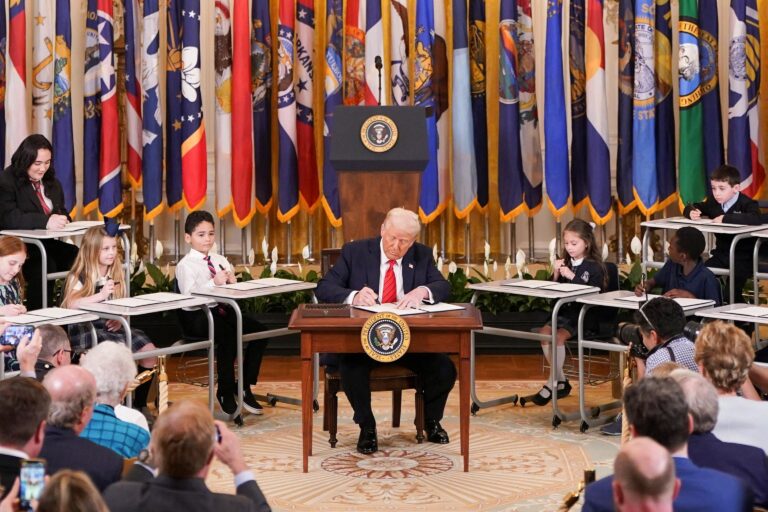In a bold and unprecedented move, former President Donald Trump has signed an executive order aimed at dismantling the United States Department of Education. The directive, announced earlier this week, sets in motion a controversial plan to significantly reduce the federal government’s role in education, prompting intense debate across the political spectrum. This development marks a dramatic shift in federal education policy, with wide-ranging implications for schools, students, and educators nationwide.
Trump Moves to Dismantle US Education Department Impact and Implications
President Trump’s executive order to dissolve the U.S. Department of Education marks a significant shift in federal involvement in education policy. This move is anticipated to redirect control over curriculum standards, funding, and regulatory oversight back to individual states and local districts. Proponents argue this will foster innovation and local accountability, while critics warn it may exacerbate educational inequality by reducing access to federally supported programs and protections for disadvantaged students.
Key implications of this policy change include:
- Elimination of federal guidelines on student assessments and accountability measures
- Reduced enforcement of civil rights protections in schools
- Potential cuts to funding for public education, particularly Title I and special education programs
- Increased administrative burdens on state education agencies
| Stakeholder | Expected Impact | Primary Concern |
|---|---|---|
| Students from low-income families | Reduced funding support | Equity and access to quality education |
| State education agencies | Greater autonomy, increased workload | Capacity to manage federal responsibilities |
| Teachers and educators | Changes to professional standards | Job security and training resources |
Analysis of Federal Education Programs at Risk Amid Policy Shift
The abrupt policy shift initiated by the new administration has placed several federal education programs in a state of uncertainty. Programs aimed at improving literacy rates, funding for special education, and initiatives supporting low-income student scholarships are facing imminent cutbacks or complete elimination. Key stakeholders in the education sector warn that dismantling the centralized Education Department will lead to a fragmented system where states struggle to fill the funding gaps. This could significantly hinder nationwide efforts to maintain equitable access to quality education.
The potential consequences of these changes can be summarized as follows:
- Reduced funding for Title I programs, threatening resources for disadvantaged schools.
- Interruptions in federal grants supporting STEM education initiatives.
- Scaling back of student loan assistance and FAFSA administration.
- Loss of oversight that ensures civil rights compliance in education.
| Program | Current Funding (2023) | Status Post-Order |
|---|---|---|
| Title I Grants | $15B | At Risk |
| Special Education | $13B | Under Review |
| Federal Student Loans | $110B | Potential Reduction |
| STEM Initiatives | $3B | Likely Cut |
Reactions from Educators and States Addressing Potential Disruptions
Educators across the nation have voiced deep concerns about the immediate and long-term consequences of the administration’s decision. Many teachers and school administrators fear that the dissolution of a central regulatory body could lead to inconsistent education standards and reduced support for underfunded schools. “We’re entering uncharted territory,” remarked one high school principal, emphasizing the uncertainty in curriculum guidelines and federal aid programs that thousands of institutions depend on.
State officials are mobilizing swiftly to counter potential disruptions, with several governors proposing state-led initiatives to maintain educational oversight. Below is a summary of some key state responses:
| State | Action Plan | Focus Area |
|---|---|---|
| California | Establishing a new state education authority | Curriculum continuity |
| Texas | Increasing funding for school districts | Resource allocation |
| Florida | Launching emergency task force | Federal aid management |
- Professional associations urge for collaborative forums between states and educators.
- Advocacy groups highlight risks to vulnerable student populations.
- Local districts prepare contingency plans for administrative continuity.
Recommendations for Navigating Changes in Federal Education Oversight
Amid significant shifts in federal education policy, states and school districts must adopt proactive strategies to maintain stability and promote student success. Collaboration between local education agencies and community stakeholders becomes crucial to offset the absence of centralized guidance. Emphasizing transparent communication channels can help ease the transition as new policies are implemented, ensuring educators and parents remain informed and engaged.
Education leaders should prioritize flexibility in curriculum development and funding allocation. Below is a table outlining essential priorities for school administrators navigating the evolving landscape:
| Priority | Action Steps |
|---|---|
| Local Control | Empower schools with decision-making autonomy |
| Community Engagement | Establish forums and feedback loops |
| Resource Optimization | Target funding toward underserved programs |
| Regulatory Compliance | Monitor evolving state-level mandates |
Key Takeaways
The decision to dismantle the U.S. Department of Education marks a significant shift in American education policy, reflecting the administration’s broader agenda to reduce federal oversight and increase state and local control. As this order moves forward, its implications for schools, students, and educators across the nation remain closely watched by policymakers and stakeholders alike. The coming months will reveal how this controversial move reshapes the landscape of education in the United States.




